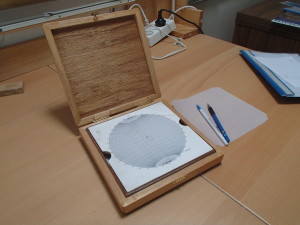Using Stereonets
Cheap, versatile, reliable, compact, robust, ultra lightweight and does not need any batteries: there should be a stereonet in every geologist’s field kit.
A stereonet is a tool (a type of nomogram[see footnote 1]) that allows the attitude of planes and lines in three-dimensional space to be shown on a specially-constructed, two-dimensional, pre-printed graph. Planes appear as straight or curved lines on the stereonet graph: lines appear as points. The attitude of a plane is uniquely defined by the attitude of the line that is at right angles to it. This line is known as the normal or the pole to the plane. The attitude of any plane on a stereonet can thus be plotted as the single point that represents its pole.

This is a Rolls-Royce model stereonet set up - most are much simpler. The graph is mounted in a storage box with room for a supply of tracing sheets in the base. The net is printed on a reversible board with an equal angle net on one side (Wulff Net) and an equal area net (Schmidt Net) on the other. A metal spike through the centre point allows articulation of tracing paper overlay. For details on how stereonets are constructed and used, see any good geology textbook (a list is given below).
Stereonets are used in structural geology in two ways:
- As a means of solving simple problems in 3-dimentional trigonometry. Exploration and mining geologists are constantly facing problems like these and their solution is critical to understanding the structure of the earth – the 3-D arrays of beds and faults and fold axes and ore bodies that are the matter of their profession. At what depth will this bed that I observe here intersect that fault there? What will be the apparent dip of an NE-dipping ore shoot on An E-W drill section? Will this plunging linear ore shoot pass below the drill hole that I plan? How do I convert the alpha and beta angles measured in core into strike and dip? (For the answer to that last question see here).
- As a means of graphically presenting the attitudes of a large number of field structural measurements on one plot. This is a statistical technique: the pattern of a large number of points on the graph can contain information about the processes operating in the domain from which the measurements were taken that may not be obvious from the raw measurements alone.
Now it is true that solving problems of 3-D trigonometry can be done mathematically. There are readily-available (albeit usually expensive) computer programs which will do this for you. I am often asked – why use a stereographic net when everything that it does can be accomplished with less mental effort by a software program? Well, here is a related question - why should I memorize multiplication tables when pocket calculators will give me the answer by just pressing a few buttons in sequence? The answer to both these questions is much the same.
There are four main reasons – they can be summed up as: mental effort is good for you, it helps you find ore bodies.
- For simple manipulations of angular relationships, using a stereonet is simply quicker than any computer program (allowing time to find your program, go through a series of pull down menus and enter data). Moreover, the stereo net can be used in the field, on top of the core tray and so on where using a computer is not always very convenient. With a little practice, stereonet lots and manipulation take only a few seconds. It is laughably-simple technology – but not therefore to be despised. It involves a re-printed graph, a thumb tack and a sheet of tracing paper.
2. The Stereo net presents orientation data in a graphical way that enables the data to be visualized. Making a stereo plot by hand forces the geologist to think in three dimensions. A mental 3-dimensionmal model is essential if the relationships between raw measurements and their geological meaning are to be understood.
3. The stereonet presents 3-D information in a way which enables any mistakes in measurement and plotting to be immediately apparent. Garbage is garbage, but computer -processed garbage can acquire a life of its own and be hard to recognize.
4. Using a computer encourages a menu-driven approach to problem solving. It tends to encourage a large number of low-quality measurements to be made in the expectation that quantity will make up for quality. In structural geology, this approach seldom works.
For these reasons, every explorationist should be familiar with simple stereo net manipulations.
For details on how stereonets are constructed and used the reader should refer to any good geology textbook. The classic (and best account, though now long out of print) is: The use of stereographic projection in structural geology by F C Phillips (Edward Arnold, 1960, 86p). A good detailed treatment is in An outline of structural geology by Hobbs, Means & Williams (Wiley, 1976, 571p). A useful and practical treatment for several stereonet procedures that are of particular value to the explorationist can be found in Geological methods in mineral exploration and mining by R W Marjoribanks (Springer, 2010, 238p). See also my own blog posts under the Tab; Stereonet solutions in structural geology.
[1] A nomogram is a physical device that provides an analog graphical way of calculating a mathematical formula. A slide rule is a nomogram, so is a stereonet.